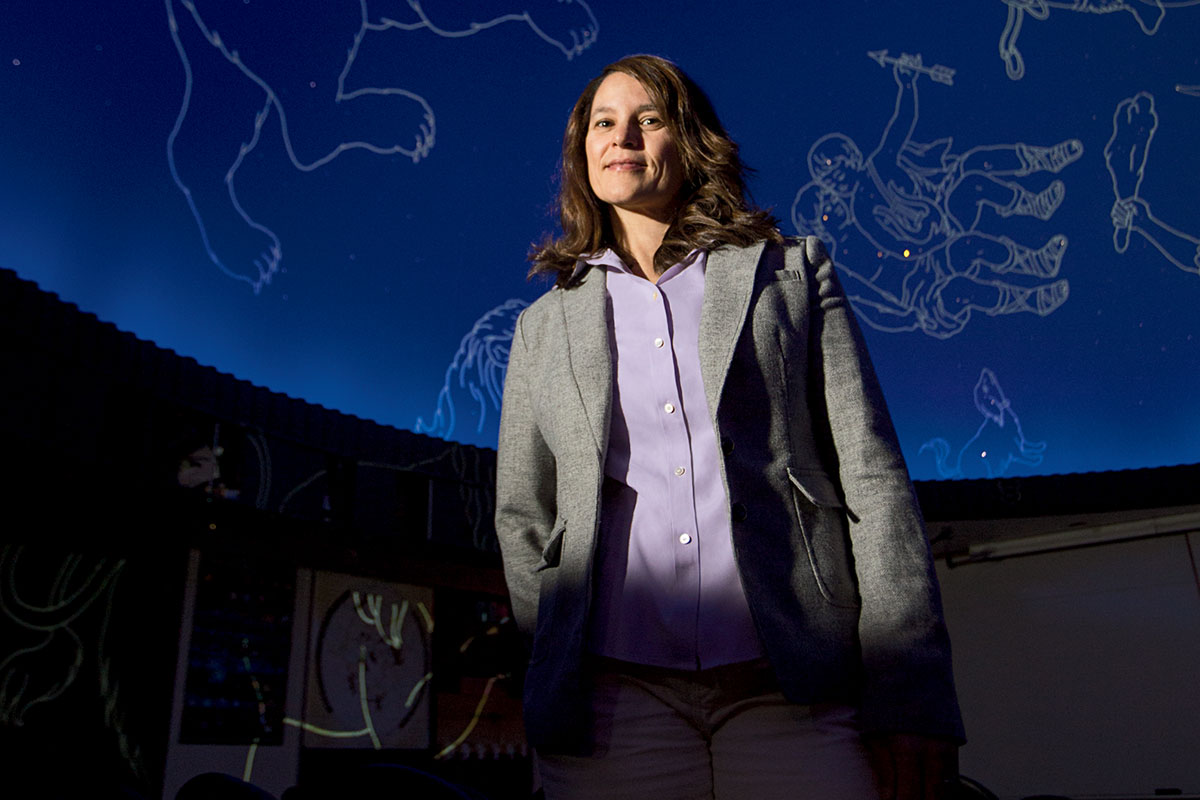The confluence of astrophysics and art meet in the studio of Annette Lee, MS ’08. An artist-scientist of Native American ancestry, Lee’s interdisciplinary work has reconnected the Dakota and Ojibwe tribes with the star knowledge her forebearers have shared for millennia.
Annette Lee’s star maps detail the constellations depicted in Native American mythology, which connect the stars of the night sky in ways that provide guidance and inspiration.
Lee’s star maps, published in 2012, detail the constellations depicted in Native American mythology, which connect the stars of the night sky in ways that provide guidance and inspiration.
Her Native Starwatchers Project holds great meaning to the people of the Dakota and Ojibwe tribes, who see the stars as their pathway to the spirit world. For example, the Dakota constellation Blue Woman/Birth Woman — which in Western astronomy is identified as the Big Dipper — is the object of prayer by midwives, as they wish newborns safe entry into the world.
“The Birth Woman is the doorkeeper between two worlds,” says Lee, who lives in Foreston, Minn., with her husband, William, and sons, Noodin, 5, and Sagaigan, 3. “We come from the stars. It is very deep, and very layered.” Her husband, an Ojibwe who speaks the language, has helped collect stories about the stars from tribal elders. Lee’s father is Dakota-Sioux and Chinese, while her mother was French, Irish and Native American.
Lee, an assistant professor of astronomy and physics at St. Cloud State University in St. Cloud, Minn., brings the 36-by-36-inch maps to Minnesota schools, tribal gatherings, and university and community lectures. Her work joins astronomy, art and Native American culture in a project that encourages Indian teens to pursue post-secondary studies in science, and rekindles interest in the ancient stories.
Lee’s work has touched the hearts of students like Jeffrey Tibbetts, Title III project director at Fond du Lac Tribal and Community College in Cloquet, Minn., where Lee taught art, mathematics and astronomy from 2001 to 2005.
“I used to look up and see the Greek constellations, like the Big Dipper, or Leo the lion,” Tibbetts says. “But now I know that there are stars up there that are ours. It does something to me inside, to have that relationship with the stars. It’s like finding a long-lost relative.”
Lee’s star maps are the culmination of an academic career that took her down two very different paths — one in science, the other in art. At the University of California, Berkeley, she majored in math while serving as a research assistant in an astrophysics lab.
There, she also delved into her cultural identity. After participating in her first vision quest — a four-day fast during which she asked the spirits for guidance — she decided to seek a second bachelor’s degree, this time in painting, at the University of Illinois in Champaign-Urbana. Her success there emboldened her to seek a master’s in painting at Yale, in one of the nation’s most prestigious art schools.
There, she developed artwork connected to native ceremonies, such as intricately painted flags used for sun dances. But science paid her bills. At Yale, she worked as a research assistant in a geophysics lab and was a teaching assistant in geology.
“When I started making the maps, I had the clarity that I was using all the skills I’d attained my entire life.”
Annette Lee
With her Yale MFA in hand in 2000, she landed a professorship at Fond du Lac Tribal and Community College. While teaching astronomy, Lee realized she wanted to delve far deeper into the science of astrophysics. That led her to WUSTL in 2005, where she was a graduate research fellow in astrophysics in the labs of professors James Buckley (physics) and Katharina Lodders (earth & planetary sciences).
“When I started making the maps, I had the clarity that I was using all the skills I’d attained my entire life,” Lee says. “I’ve gone like a pendulum, back and forth between art and science. And now I’ve reached the pinnacle. I never would have been able to make the maps before now.”
David McKay Wilson is a freelance writer based in New York.
